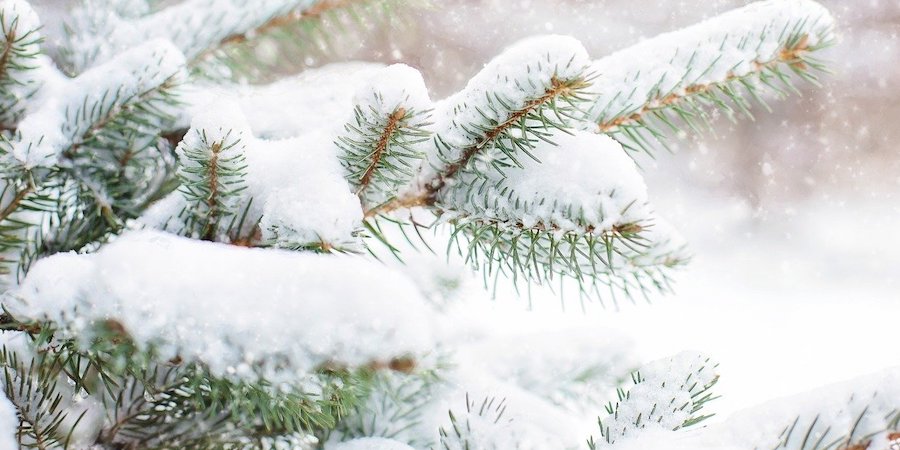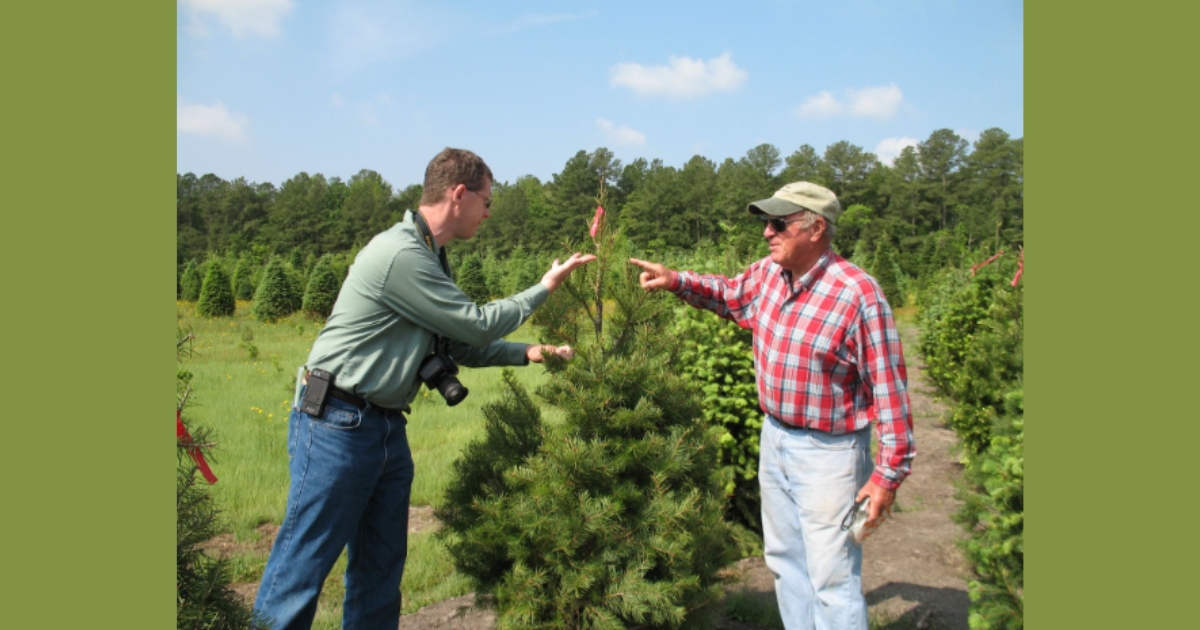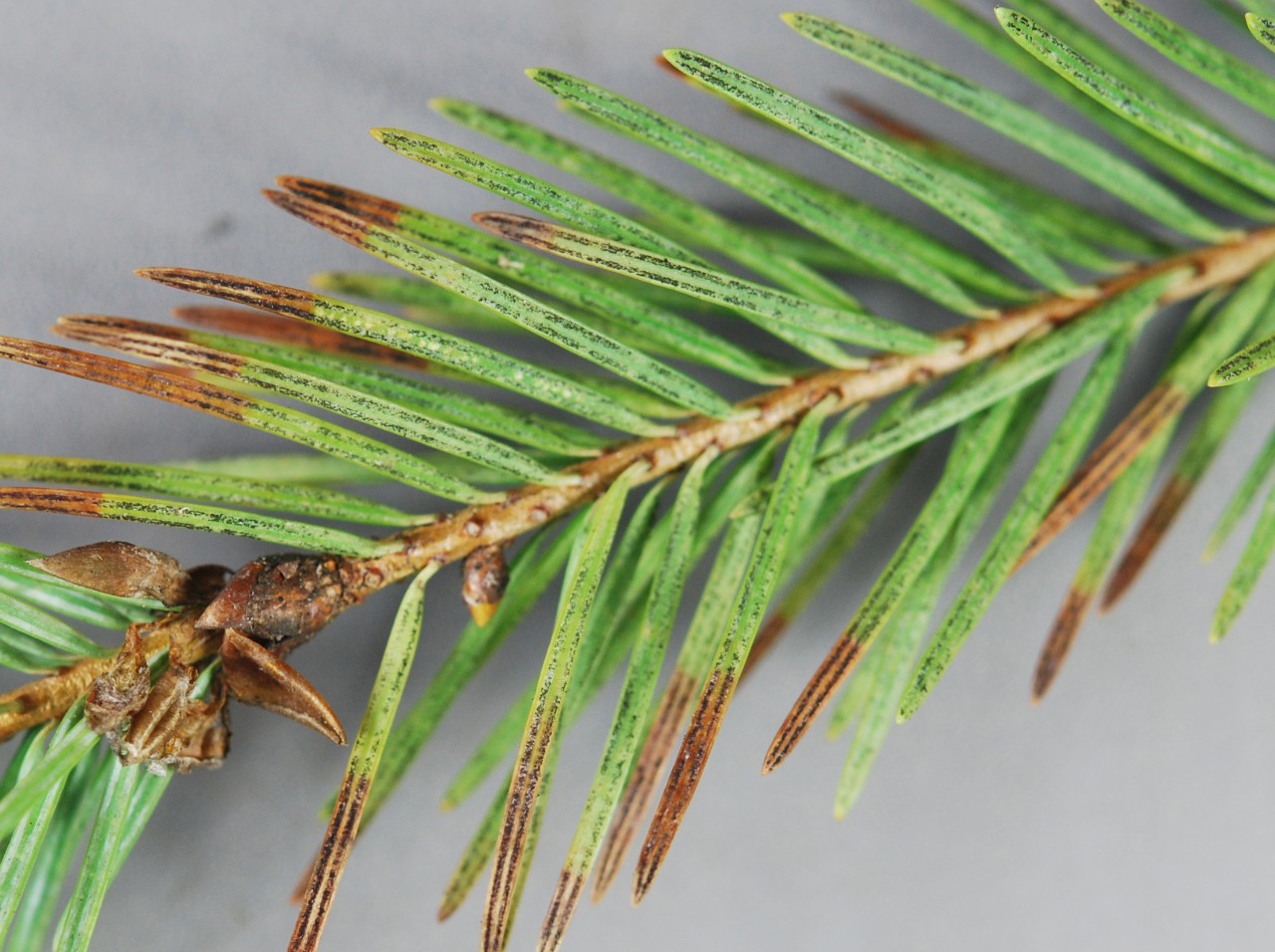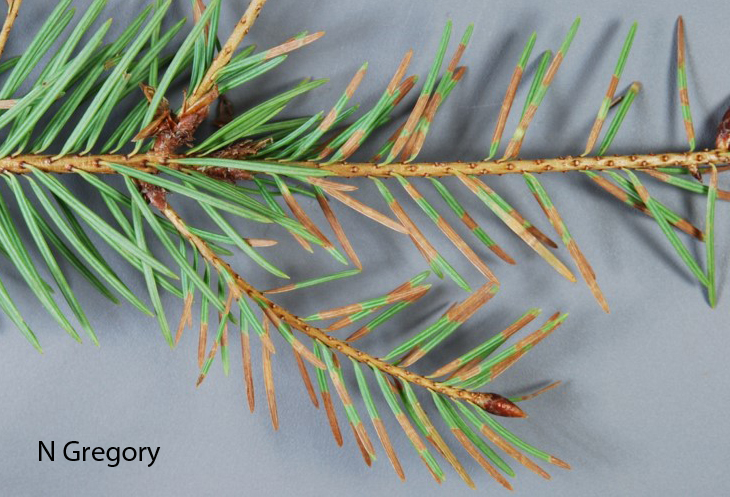
Fact Sheets And Publications

Delaware Christmas Trees
August 2025 / Written by: Nancy Gregory, Plant Diagnostician, Retired
Cultural Information
Delaware and regional Christmas tree growers deal with many challenges in growing a perfect tree, an expensive and time-consuming process. Trees that are popular for Christmas trees include Douglas fir, Fraser fir, Canaan fir, Concolor fir, white pine, and several spruces. Cultivars or selections are available as seedlings, and a Christmas tree takes eight to ten years to grow to a good size. Trees must be planted properly in good soil, not too shallow or deep. It may take up to three years for a transplanted seedling to establish a good root system. Proper fertilizer, watering, and pruning occur each year, along with scouting for arthropod pests and diseases.

Diseases and Diagnosis
Foliar needle blight on evergreen trees is referred to as needle cast. Most often, needle cast is caused by infection with a fungal pathogen, resulting in spots, distortion, yellowing, and the ultimate drop of affected needles. Rhabdocline, Stigmina, and Swiss needle cast fungi cause spotting and discoloration of needles on Christmas trees. Bagworms, midges, and mites also cause pest-related losses. Specific diagnoses may be made by trained scouts or diagnostic labs.


Phytophthora root rot is problematic on tree farms in many states, and results in stunted, off-color trees that die prematurely. Phytophthora is a fungus-like organism, favored by wet, saturated soils with poor drainage, resulting in root stress.
Management
Growers must scout their trees, apply fertilizer and pest control, trim to shape, and keep up with research on tree species and new cultivars. The best farm management strategies are to purchase clean healthy seedlings, prepare a proper site, and water appropriately, because the best possible control is avoidance of root rot and needle blight fungi in the first place.
Disease and pest management on farms is aided by sanitation, removing plant debris from previous years, removing affected plants early in infection, avoiding over-crowding, increasing air circulation, maintaining good plant vigor, and reducing stress on susceptible hosts. Removing nearby weed hosts may also help slow the spread of disease and pests. Watering during drought, avoiding overhead water, mulching, taking care to avoid wounding, and avoiding chemical injury are all best practices. Resistant cultivars may be available for some tree types. If specific fungal pathogens are detected, preventative fungicide spray programs may be warranted.
Sales of trees, following ten years of nurturing, occur yearly within a 3 to 6 week period. Delaware Christmas tree growers are dedicated agricultural professionals who also may promote choose and cut, agri-tourism, hay rides, and other ventures.
Choosing and Caring for Christmas Trees
Many of us choose a fresh-cut tree to decorate our homes for the holiday season. Choose a tree with dark green color, good shape, a straight trunk at the base, and no taller than you really need. Check to see if the tree is fresh by bending needles; they should bend and not break. Needles should not fall off in great numbers, but some needle drop is standard. Have the vendor make a fresh cut of about 1/2 inch at the base, or do so yourself. Cut off small, low branches; do not pull off. Some vendors will trim, shake, and wrap for transport. Choose a good location in your home for your tree, not in a sunny window or near a fireplace or heat vent. Until you bring it indoors, keep the tree in a cool, shady location, and stand it up in a bucket of water. Cut trees take up a lot of water in the first 5 days. Inside, use a tree stand that can hold at least a quart or two of water. Add water daily and try not to let the water level go below the cut end of the tree, or resin on the cut surface will cause it to stop taking up water. There are many recommendations, but adding a little lemon-lime soda, vinegar, or mouthwash to tree water may help keep bacteria levels low and trees fresh a bit longer. Keeping the thermostat set cool (about 68°F) will help a tree last longer.
Some people choose a live tree that has roots and soil wrapped in burlap. These trees can be planted outside after the holidays, but time indoors adds to the stress of transplanting. Live trees should not be kept inside for more than about 8-10 days. A hole for planting should be prepared ahead of time if there is a risk that the soil may freeze. Live trees are heavy and more expensive, but serve as a lasting memory. Cut trees must be discarded, but can be left out for wildlife, or municipalities may chip them for mulch.
Reference to commercial products or trade names does not imply endorsement by University of Delaware Cooperative Extension.
UD Cooperative Extension
This institution is an equal opportunity provider.
In accordance with Federal law and U.S. Department of Agriculture policy, Cooperative Extension is prohibited from discriminating on the basis of race, color, national origin, sex, age, or disability.
